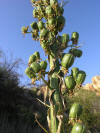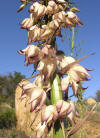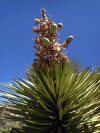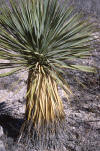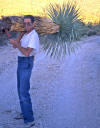|
Hesperoyucca whipplei
|
Hesperoyucca whipplei
|
Hesperoyucca whipplei |
|
Tejon Ranch Conservancy, CA |
||
|
Kern Co., California, Kelso Valley, June 2016. |
Kern Co., California, Tehachapi Mts., Tejon Ranch Conservancy, May 2016, Antelope Valley region
|
Yucca brevifolia ssp. jaegeriana |
|
Kern Co., California,
Tehachapi Mts., Tejon Ranch Conservancy,
|
Yucca brevifolia
ssp. brevifolia
|
Yucca
constricta
|
|
Yucca elata |
Yucca faxoniana
|
Yucca harrimaniae
|
|
Yucca schidigera |
Yucca schidigera
|
Yucca schidigera? Google Earth
Image, Street View, Kern Co., CA, northwest of Mohave along south side
of Hwy 58, |
|
Yucca thompsoniana
|
Yucca valida |
|
| Trees and Shrubs of Kern County (Jan 2013, July 2016) Hesperoyucca whipplei (Yucca whipplei Torrey 1859) Baker ex Trelease 1893 [Includes Y. whipplei ssp. caespitosa (var. caespitosa M. E. Jones 1929) A. L. Haines 1941; ssp. percusa A. L. Haines 1941]. Quixote plant. Leaf rosette from the ground (no trunk); leaves thick, spine tipped, 0.4–1 m long, yellow to green along margin, expanding at base 4–7 cm wide and long, spine-tipped, spine 1–2 cm; flowering Apr–Jun; main flower stalk often arising acentrally, thick, up to 4 m long; the flowering portion of the inflorescence ellipsoidal; flowers creamy white with green or purple-tinge; gynoecium of 3 united carpels (syncarpous), each carpel 2-celled; fruit a loculicidal capsule, 3-valved; plant dying after fruiting (monocarpic), or surviving if plant with more than one leaf rosette (polycarpic). Common in chaparral of Coast and Peninsular Ranges of southern California, across the woodlands to the western margins of the deserts, north to Monterrey and San Benito Cos., south into Baja California, from near sea level to 8,000 ft. Type from near Pasqual, CA. Kern Co.: Widely distributed in the woodlands and on the “rim of the Kern Plateau to 7,000 ft” (Twisselmann), 728–2133 m (Twisselmann; CCH, 8 collections, 4 with elev. data). Hesperoyucca whipplei Shrubland Alliance proposed as seen on Tejon Ranch Conservancy (Magney 2010, Michener [Los Angeles Co.]. Variable in length of flowering stems and leaves. DNA studies support recognition of Hesperoyucca, an earlier genus name. Two other species in the genus, one along the Colorado River in northwestern Arizona, the other in northern Baja California (Clary 2002 in FNA). Additionally, five subspecies or four varieties of H. whipplei were distinguished based on differences in growth form (Haines 1941; Webber 1953; Munz 1959). Only one or two in Kern County were noted by Twisselmann, var. caespitosa, rosettes in clumps, widely distributed, and a possibly ssp. percusa, a colonial “form” occasional in the Temblor Range, and rare on Orchard Peak. However, the need for conclusive DNA studies was indicated by Clary (2002 in FNA) to better define the subspecies, which have not been recognized in more recent floras (McKinney & Hickman in JM1; Hess in JM2). Yucca. Plants with fibrous stems and simple fleshy evergreen leaves, shrub or tree-like; leaves in rosettes at base or at clustered at ends of trunk-like stems, generally sword-shaped, ending in a rigid spine; flowers fleshy in terminal branched scapes; fruit fleshy and indehiscent, or dry and gradually opening along carpel margins (septicidal), or irregularly breaking apart. ±40 spp, mostly semi-arid regions of New World; 7 used medicinally by native Americans, but none occur in Kern County (Moerman); 6 active in SA due to saponins, which have been regarded not to have therapeutic value for treating cancer (Hartwell). Yucca brevifolia Englemann 1871. Joshua tree. Plants with erect to spreading trunks, branched at base or above; leaves in whorls near the stem tips, or on off-shoots near base of turnk, stiff, sword-shaped, expanded near base, 15–40 cm long, margins denticulate, not fibrous, spine tipped, spine 7–12 mm. Flowering Mar–May, inflorescence thick, dense, short, conical, bracts conspicuous in youth, triangular-sword shaped, long drawn-out to tip, bractlets exserted or included, deltoid or narrow triangular, abruptly tapered to a short to long drawn-out tip, persistent or not evident after flowering; tepals fleshy, united near base, cucullate (hood-shaped) incurved, or ribbon-like and recurved to incurved near tip, cream to greenish white; fruit: 6-celled carcerulus, short cylindric to ellipsoid or obovoid, 6–8.5 cm long, spreading to pendant, fleshy when immature, becoming dry and spongy, indehiscent. A characteristic tree of the Mojave Desert above Yucca schidigera desert in transition to the pinyon and juniper woodlands, from 2,000–6,000 ft. Generally, eastern slopes of southern Sierra Nevada, inland in Kern County to Tejon Pass, east to southwestern Utah, western Arizona. Type from the north bank of the Mojave River just southwest of Barstow, San Bernardino Co., CA, collected by John Bigelow, 15 Mar 1854 (Reveal in Cronquist et al., Intermountain Flora 6: 1977). “Joshua tree woodland” (alliance) recognized in MCV2 when ≥1% cover and juniper and pine <1%. Kern Co.: Common in dense stands in the desert transitions to oak and pinyon-juniper woodlands. Yucca brevifolia-Juniperus californica Woodland Alliance proposed, Tejon Ranch Conservancy (Magney 2010, Tri-Centennial), 677–1677 m (CCH). Twisselmann recognized two varieties in Kern County. The typical variety (var. brevifolia), “Joshua tree,” “forms an extensive woodland on the plains between Soledad Mountain and the base of Tehachapi Mountains. It occurs sporadically on the rest of the desert plains and in the canyons and mesas of the El Paso Range” The second variety, Y. brevifolia var. herbertii (Y. b. forma herbertii Webber 1953) Munz 1959, “Kern Joshua,” is “a distinctive Joshua tree that reproduces freely from underground rootstocks,” forming “dense colonies of usually branched trees,” occurring “from antelope Valley in northeastern Los Angeles County to Walker Pass and the Upper South Fork Valley;” type from west end of Antelope Valley, Los Angeles County, 21 miles west of Lancaster, Calif., 2,940 ft, collected by J. M. Webber, 11 Apr 1946. Later authorities have not accepted Yucca brevifolia var. herbertii because the off-shoot characteristic is not consistent among all plants within the range (Lenz (2007, citing two lengthy Ph.D. dissertations on Joshua tree, and his own observations). Yucca brevifolia var. jaegeriana McKelvy (1935) was recognized as the eastern Mojave Joshua tree (Lenz 2007) by its dwarf habit (< 4m) and shorter leaves (10–20 cm) based in part on Jaeger’s field observations and communications with McKelvy. However, Reveal (in Cronquist et. al. 1977), found that specimens from western Mojave Desert have relatively short leaves, the longest leaves in the type from near Barstow only 9.5 cm. This is in contrast to Munz (1959 who described var. brevifolia leaves to be 25–40 cm long. Thus, Reveal (1977) proposed that Joshua trees in the mountains surrounding the Mojave Desert “deserve” varietal distinction based on their longer leaves, but indicated that more detailed study was needed. Lenz (2007) subsequently distinguished it as a species by its relatively short trunk (<1 m), dichotomous vs. monopodial branching, shorter leaves, 10–20 cm in contrast to 15–35 cm, longer cucumber-like vs. short football-like fruit, and narrow ribbon-like recurved vs. broader incurved cucculate tepals. however, leaf length given by Lenz (2007) for var. brevifolia, 15–35 cm, excluded the type, which only has leaves, whereas short branched trunks near base had been recognized for var. herbertii.. Thus, Joshua trees with longer leaves would seem to belong to an undescribed variety proposed by Reveal (1977), while differences in the floral morphology seemed to be the only distinguishing character for the species. A genetic analyses from cpDNA of 34 “phylogenetically defined species” of Yucca that included four specimens of Y. brevifolia (s.l.) from different locations—Palmdale CA, Kingston Mts. CA, Potosi Canyon NV (Spring Mts.), and Shivits UT—showed the Joshua trees from the Kingston and Spring mountains were more closely related as might be expected, whereas the Palmdale and Utah plants showed a close genetic relationship (Smith et al. 2008a). Additionally, flowers of Y. jaegeriana are reportedly pollinated by the moth Tegeticula antithetica, in contrast those of Y. brevifolia pollinated by T. synthetica, a sister species (Lenz 2007; Smith et al. 2008b); however, hybridization is evident between the two yucca species where their geographic ranges overlap, thus, the earlier subspecies status was considered more appropriate (Starr et al. 2013), Y. brevifolia subsp. jaegeriana (McKelvey) Hochstätter 2001. The two subspecies may be distinguished by their flowers, ssp. jaegeriana with flowers that fully open with ribbon-like tepals recurved near tips (image not determined to subsp, Wikimedia Commons, Stan Shebs, Red Rock Canyon, NV, and ssp. brevifolia flowers nearly closed-up by the incurved elliptical hood-like tepals (Wikimedia Commons images, David Scriven, Kramer Junction; Stan Shebs, Cameron Exit, Hwy 58, north end of Tehachapi Mts.). Mojave ground squirrels, other rodents, and wind are primary seed dispersal agents of Joshua tree (Lenz 2001) since most of the fruits on trees are generally out of reach of modern day large mammals; however, Lenz (2001) postulated that fruits of ancestral Joshua trees, perhaps dating back to the mid Miocene (15 mya), were food for camelids, gomphotheres, mastodons and mammoths; these are large African savanna-like mammals that roamed North America until ~13,000 years ago (Lenz 2001). The close association between pollination of the Joshua trees by species of moths (Tegeticula) is perhaps not older than 10 million years (Smith et al. 2008b). The moth lays its eggs in the ovaries of the Y. brevifolia flower, and the larvae subsequently feed on the seeds, but not all are destroyed. The night lizard, Xantusia vigilis, lives in the bark of Joshua tree, feeding on termites, ants, and insect larvae (Jaeger 1941). Various other animal interactions with Joshua tree were reviewed by Lenz (2001). .Yucca schidigera Ortgies 1871. Mohave yucca. Usually several short trunks in a rosette, 1–5 m high; leaves in rosette, yellowish green, sword-shaped, curled inwards, or keeled along midrib, thick, 33-130 × 3-5 cm, rigid, with curly white fibers scattered along margins, tip with spine 7–12 mm. Flowering Apr–Jun; leafless flower stalks 1-several, the flowering portion cylindrical in outline, to 40 cm long; flowers pendant, maroon in bud, white to cream with pale maroon bands; fruit spreading to pendant, indehiscent, 6-celled hesperidium. Generally rocky slopes in the Mojave Desert, 2000–5500 ft, Peninsular Ranges, coastal sage and chaparral in San Diego Co. to near sea level, to Baja California, Arizona and Nevada. “Mojave yucca scrub” (alliance) recognized in MCV2 when ≥ 2% absolute cover in the shrub or small tree canopy in which burro bush and creosote may be equal or higher. Type from near San Diego, CA. Kern Co.: One record from ~8 km northwest of Mojave, 0.8 km north of Cache Creek. 0.3 km south of Highway 58, 1220 m [~4,000 ft], 3 m tall, petals cream white, small population in creosote bush scrub on fine sandy loam, Dann Fischer, 14 Apr 1981 (CCH-CHSC). Cache Creek lies on the south side of Hwy 58 along a rail line from Sand Canyon at 1159 m (3,802 ft), ~12 km west to northwest of Mohave, to ~1000 m, ~7 km north of Mohave. In “Street View” of Google Earth, Mohave yucca appears evident among Joshua trees at widely scattered intervals between 3,400 and 3,300 ft, ~ 7–8 km nw of Mohave, where a gap between Cache Creek and Hwy 58 is at least 1.1 km. But the images are not sharp; therefore, confirmation needs to be made by ground where it appears not practical to stop along the highway as it may have been in 1981. A second collection by A.B. Clayton in June 1932 (CCH-UC) indicating only the county name without any specific location is questionable based on the sketchy data for this and other specimens he collected during that time (CCH), many of which were from San Diego County, where Mohave yucca is common.
|
||


